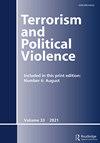The Extreme Right, Climate Change and Terrorism
IF 2.1
2区 社会学
Q1 INTERNATIONAL RELATIONS
引用次数: 3
Abstract
ABSTRACT “Eco-fascism” has recently regained prominence following two of the most lethal extreme right terrorist attacks: the murderous assault on two mosques in Christchurch, New Zealand, which killed fifty-one, and the massacre at a Walmart in El Paso, Texas, which killed twenty-two. Both of these attacks were justified by their perpetrators, at least in part, in environmental terms. Brenton Tarrant, the Christchurch terrorist, went so far as to proclaim himself an “eco-fascist.” Whilst “radical right” populism is often associated with climate denial, “extreme right” environmentalism, with its roots in the “blood and soil” thinking of Nazism, is concerned with protecting the spiritual link that supposedly exists between man and nature. Having established the historical lineage of such ideas, the article explores how contemporary extreme right groups have reacted to population growth, migration, and climate change. It explores the emergence of a particular form of “dark green” environmentalism that builds upon the “blood and soil” ideas of Nazism, synthesizing them with an anti-human ecology derived from several sources including Greco-French Hitler-worshipper Savitri Devi; the “Unabomber” Ted Kaczynski; and the Finnish environmentalist and misanthrope Pentti Linkola. The misanthropic ideas of these three ideologues and their extreme “solutions” to environmental degradation and overpopulation represent an increasingly prevalent ideological tendency within extreme right subcultures online. The violent panaceas they advocate and envisage as being necessary to defend the natural environment will undoubtedly gain greater prominence as climate change-driven migration northwards to Europe intensifies.极右翼、气候变化和恐怖主义
摘要“生态法西斯主义”最近在两起最致命的极右翼恐怖袭击后重新凸显:新西兰克赖斯特彻奇两座清真寺遭到谋杀袭击,造成51人死亡;得克萨斯州埃尔帕索沃尔玛发生大屠杀,造成22人死亡。这两起袭击事件的肇事者至少在一定程度上从环境角度为其辩护。克赖斯特彻奇恐怖分子布伦顿·塔兰特甚至宣称自己是“生态法西斯主义者”。虽然“激进右翼”民粹主义经常与否认气候变化联系在一起,但“极右翼”环保主义植根于纳粹主义的“血与土”思想,关注保护人与自然之间的精神联系。在确立了这些思想的历史谱系后,文章探讨了当代极右群体对人口增长、移民和气候变化的反应。它探索了一种特殊形式的“深绿色”环保主义的出现,这种环保主义建立在纳粹主义的“血液和土壤”思想之上,并将其与源自多种来源的反人类生态相结合,包括希腊-法国希特勒崇拜者Savitri Devi;“Unabomber”Ted Kaczynski;以及芬兰环保主义者和厌世者Pentti Linkola。这三位理论家的厌世思想及其对环境退化和人口过剩的极端“解决方案”代表了网络极右亚文化中日益普遍的意识形态趋势。随着气候变化导致的向北欧洲移民的加剧,他们倡导并设想的保护自然环境所必需的暴力灵丹妙药无疑将变得更加突出。
本文章由计算机程序翻译,如有差异,请以英文原文为准。
求助全文
约1分钟内获得全文
求助全文
来源期刊

Terrorism and Political Violence
Multiple-
CiteScore
5.60
自引率
8.30%
发文量
87
期刊介绍:
Terrorism and Political Violence advances scholarship on a broad range of issues associated with terrorism and political violence, including subjects such as: the political meaning of terrorist activity, violence by rebels and by states, the links between political violence and organized crime, protest, rebellion, revolution, the influence of social networks, and the impact on human rights. The journal draws upon many disciplines and theoretical perspectives as well as comparative approaches to provide some of the most groundbreaking work in a field that has hitherto lacked rigour. Terrorism and Political Violence features symposia and edited volumes to cover an important topic in depth. Subjects have included: terrorism and public policy; religion and violence; political parties and terrorism; technology and terrorism; and right-wing terrorism. The journal is essential reading for all academics, decision-makers, and security specialists concerned with understanding political violence.
 求助内容:
求助内容: 应助结果提醒方式:
应助结果提醒方式:


